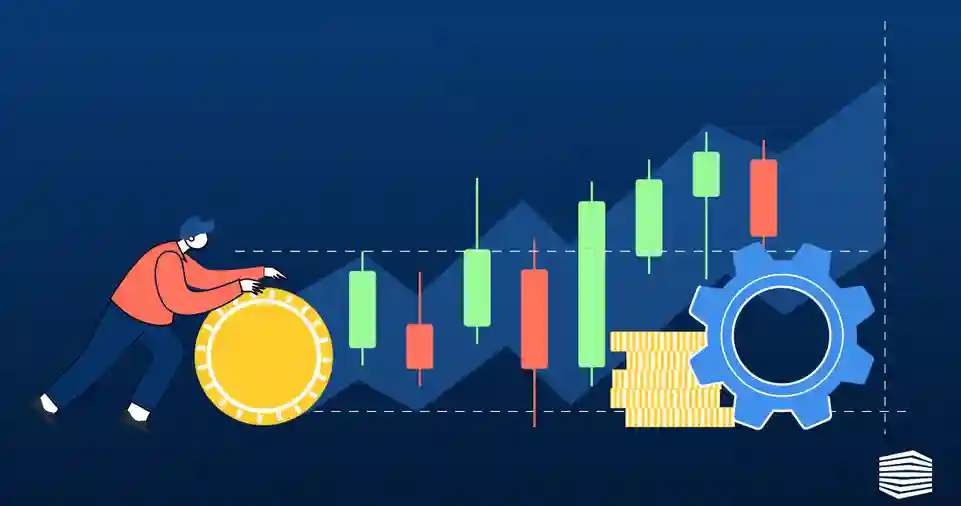The cryptocurrency world has revolutionized how people view investing, creating new avenues for passive income.
Traditional forms of passive income, such as interest from savings accounts or dividends from stocks, are limited by low returns.
However, cryptocurrencies offer high-yield options like yield farming and staking that can be highly profitable for those who understand how they work.
These methods allow investors to earn passive income while minimizing the need for active trading or involvement in day-to-day activities.
In this article, we’ll explore the two most popular passive income strategies in crypto: yield farming and staking.
We will break down how they work, the platforms that support them, the risks involved, and how you can start earning passive income with your crypto holdings.
Whether you’re new to crypto or a seasoned investor, understanding these concepts is essential for diversifying your income streams and maximizing your potential returns.
Let’s dive deeper into how you can make your crypto assets work for you.
Introduction to Passive Income with Crypto
Cryptocurrencies have taken the financial world by storm, introducing a decentralized alternative to traditional investment vehicles.
Along with buying and holding assets for capital appreciation, crypto offers innovative ways to earn passive income.
This can be achieved by utilizing mechanisms like staking and yield farming, which allow investors to earn rewards over time by locking their assets into certain networks or platforms.
Unlike traditional investment methods, where your capital is tied up in stocks or bonds, these crypto mechanisms offer a chance to earn rewards while maintaining control over your assets.
The crypto market, while volatile, provides opportunities for high yields, often outpacing conventional investment options.
Yield farming and staking are two of the most widely used passive income methods that allow users to maximize returns without the need for daily trading.
Understanding these mechanisms can be key to building a profitable portfolio in the world of decentralized finance (DeFi).
By the end of this article, you will have a clear understanding of how to earn passive income through crypto, the risks involved, and how to get started.
What is Yield Farming?

Understanding Yield Farming in Crypto
Yield farming is a process that allows crypto holders to earn passive income by providing liquidity to decentralized finance (DeFi) platforms.
In the DeFi space, yield farming typically involves users depositing their crypto assets into liquidity pools on decentralized exchanges (DEXs) or lending platforms.
These liquidity pools facilitate trading or lending, and the users who provide liquidity are rewarded with fees and additional tokens.
The concept of yield farming is akin to traditional farming, where you “plant” your crypto into a liquidity pool and “harvest” the rewards.
The rewards, in the form of interest or tokens, are a percentage of the transaction fees paid by others using the pool. The more liquidity you provide, the higher the potential rewards.
Yield farming platforms reward liquidity providers in two ways: transaction fees and additional tokens.
In some cases, the tokens earned from yield farming are native to the platform (such as Uniswap’s UNI token), and in other cases, they can be a share of the trading fees.
How Yield Farming Works
In a decentralized exchange like Uniswap, liquidity is needed for users to make transactions.
When you provide liquidity to the platform, you essentially allow others to trade between different pairs of tokens.
For example, if you provide liquidity to a token pair like ETH/USDT, users can trade between Ethereum (ETH) and Tether (USDT), and you will earn a portion of the transaction fees.
In addition to the trading fees, liquidity providers are often rewarded with platform-native tokens.
These tokens can either be used for governance (voting on protocol decisions) or can be sold for profits.
Some platforms also offer liquidity mining programs, where users receive extra rewards based on their participation in the liquidity pool.
To participate in yield farming, the following steps are typically involved:
- Select a Platform: Choose a DeFi platform that supports yield farming, such as Uniswap, SushiSwap, or PancakeSwap.
- Choose a Pool: Once you’ve selected a platform, choose a liquidity pool to invest in. Pools usually consist of pairs of tokens (e.g., ETH/USDT, BTC/USDT).
- Deposit Tokens: Deposit your tokens into the liquidity pool. When you do this, you receive liquidity pool (LP) tokens, which represent your share of the pool.
- Earn Rewards: As trades occur within the pool, you earn a portion of the transaction fees and any native token rewards offered by the platform.
- Withdraw or Reinvest: Depending on the platform, you can withdraw your rewards or reinvest them into other pools.
Risks and Considerations in Yield Farming
While yield farming can be very profitable, there are several risks involved:
Impermanent Loss:
If the price of the assets in the liquidity pool changes significantly, you may end up with a smaller value when you withdraw your assets compared to what you initially deposited. This phenomenon is known as impermanent loss.
Smart Contract Risk:
Yield farming platforms are built on blockchain technology, which relies on smart contracts.
These smart contracts are susceptible to bugs or hacking attempts. If a platform is compromised, you risk losing your funds.
Market Volatility:
Cryptocurrencies are inherently volatile. If the price of the tokens in your liquidity pool drops significantly, your reward may not offset the losses.
Despite these risks, many investors choose to engage in yield farming due to its potential for high returns.
Careful selection of pools and platforms, as well as diversification, can help mitigate these risks.
ALSO READ: How to Analyze Crypto Markets Trends and Make Informed Decisions
What is Staking?

Understanding Staking in Crypto
Staking is another popular way to earn passive income from crypto.
Staking involves participating in the proof-of-stake (PoS) consensus mechanism by locking up a certain amount of cryptocurrency in a wallet to help secure the network and validate transactions.
In return, you earn rewards in the form of additional tokens or coins.
The most well-known PoS blockchain is Ethereum 2.0, which has transitioned from proof-of-work (PoW) to PoS to make the network more energy-efficient and secure.
Other prominent PoS blockchains include Cardano (ADA), Polkadot (DOT), and Tezos (XTZ).
When you stake your tokens, you are effectively contributing to the blockchain’s security by validating transactions.
Validators are selected to produce new blocks and confirm transactions, and in return, they earn staking rewards.
These rewards are distributed to stakers as an incentive for participating in the network’s maintenance.
How Staking Works
To participate in staking, you must lock your tokens in a staking wallet or a staking pool.
If you’re staking on a platform like Binance, Kraken, or Ethereum 2.0, you will need to:
- Select a Staking Network: Choose the blockchain that supports staking, such as Ethereum 2.0 or Cardano.
- Transfer Tokens to the Staking Wallet: Transfer your crypto assets to a staking wallet or a staking pool on the platform.
- Choose a Validator or Pool: On some networks, you can choose a validator to delegate your tokens to. Alternatively, you can stake in a pool where multiple users contribute their assets to a common pool.
- Earn Rewards: As a staker, you earn rewards for helping secure the network and validate transactions. The rewards vary depending on the network and the amount staked.
- Unstaking: After a lock-up period, you may choose to unstake your tokens. Keep in mind that some networks have specific periods during which you cannot unstake your tokens.
Risks and Considerations in Staking
While staking offers relatively stable returns, it is not without risk:
Lock-Up Periods:
Some staking platforms have lock-up periods during which you cannot access or withdraw your staked tokens.
This limits flexibility and exposes you to market volatility.
Slashing:
If you are staking on a network that uses a PoS consensus mechanism, there’s a risk of slashing.
Slashing happens if the validator you’ve delegated to misbehaves or fails to properly validate transactions, resulting in a loss of part of your staked tokens.
Platform Risk:
If you stake through a third-party platform like Binance or Kraken, the platform could potentially face security breaches or regulatory issues that might affect your staked assets.
Staking is generally considered less risky than yield farming, but like all crypto activities, it still carries inherent risks.
Always research the network and platform you’re staking on, and consider staking with a reputable validator or pool.
Yield Farming vs Staking: Which is Better for Passive Income?
Comparing Yield Farming and Staking
Both yield farming and staking allow you to earn passive income with crypto, but they come with different risk profiles and potential rewards.
Below is a comparison of the two strategies:
| Feature | Yield Farming | Staking |
|---|---|---|
| Potential Rewards | High returns (up to 100%+ APY) | Moderate to high returns (5-20% APY) |
| Risks | Impermanent loss, smart contract risk, volatility | Slashing, lock-up periods, platform risk |
| Liquidity | Can withdraw anytime (depending on the platform) | Limited liquidity (depends on the network’s rules) |
| Complexity | More complex (requires understanding of pools) | Simpler (easy to stake tokens in most platforms) |
| Maintenance | Requires regular monitoring | Low maintenance once tokens are staked |
Which Should You Choose?
If you’re looking for high returns and are willing to take on more risk, yield farming could be the right choice.
On the other hand, if you prefer a simpler, more secure method of earning passive income with moderate returns, staking might be a better fit.
ALSO READ: How to Identify and Invest in Emerging Cryptocurrencies
Conclusion: Maximizing Passive Income with Crypto
Earning passive income with crypto through yield farming or staking is an excellent way to make your assets work for you.
Both methods offer unique benefits and challenges, and understanding their mechanics, risks, and rewards is crucial for making informed decisions.
Whether you opt for the high-reward potential of yield farming or the stable income provided by staking, you can build a diversified crypto portfolio that generates passive income while you sleep.
Always remember to conduct thorough research, diversify your investments, and manage your risks to make the most of these opportunities.
Crypto offers many ways to earn passive income, but success requires careful planning and strategy.











